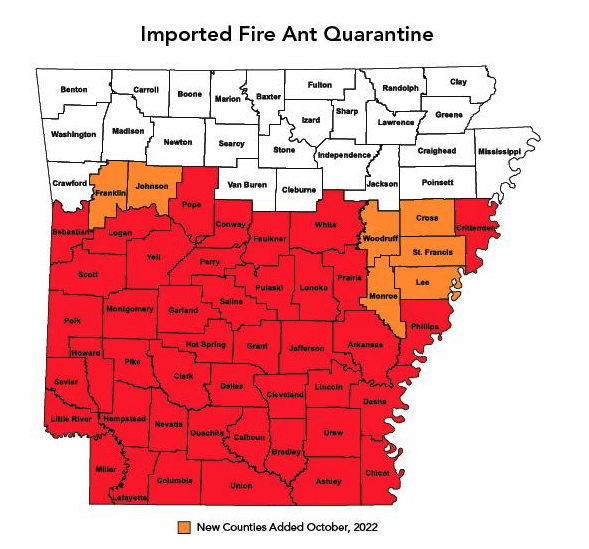Fire ant quarantine expands to include seven new Arkansas counties
The U.S. Department of Agriculture has expanded an Imported Fire Ant quarantine in Arkansas to include seven new counties, bringing the quarantined area in the state to 50 counties.
Nov. 16, 2022
By Ryan McGeeney
U of A System Division of Agriculture
Fast Facts:
- Quarantine now covers 50 of the state’s 75 counties
- Fire ants are invasive, displacing native ants
- Division of Agriculture fact sheet can help homeowners control infestations: https://www.uaex.uada.edu/publications/PDF/FSA-7036.pdf
(430 words)
(Newsrooms: With quarantine map at https://flic.kr/p/2nZtLAW; download “Fire Ant Control in Two Easy Steps” here.)
LITTLE ROCK — The U.S. Department of Agriculture has expanded an Imported Fire Ant quarantine in Arkansas to include seven new counties, bringing the quarantined area in the state to 50 counties.
The quarantine, issued through USDA’s Animal and Plant Health Inspection Service, confirms the presence of the invasive species in Cross, Franklin, Johnson, Lee, Monroe, St. Francis and Woodruff counties. The new quarantine area essentially includes the southern two-thirds of Arkansas.
Kelly Loftin, extension entomologist for the University of Arkansas System Division of Agriculture, said that the ants have been introduced northward over the decades through the movement of plant nursery items, grass sod, soil and baled hay. But that doesn’t mean business owners in these industries must shut down.
“If you’re running a nursery or sod farm, it’s just a matter of entering a compliance agreement with the Arkansas State Plant Board, agreeing to certain procedures that will help enforce the quarantine,” Loftin said. “It means you have to follow certain, very specific treatment programs to make sure that product is free of fire ants.”
Loftin said the red imported fire ant was first confirmed in Arkansas in Union County in 1958, having first crossed the southern border of the United States in the 1930s. Previous efforts to eradicate them in Arkansas have failed.
“That was tried decades ago, and it was unsuccessful,” Loftin said. “And that was at a time when you had products with a lot of residual presence — you also had products that weren’t as restricted, in terms of where they were used. So, if it didn’t work then, when the products were longer lasting, it sure won’t work now.”
Paul Shell, head of the Arkansas State Plant Board’s plant inspection and quarantine efforts, said the insect’s progress northward is primarily limited by cold seasonal temperatures.
“They are suppressed by sustained cold weather,” Shell said. “There’s a northern limit to where they’re going to be perennial.”
Shell said the fire ants will often overwinter near asphalt sidewalks or in parking lots, where the artificial surfaces help to radiate heat into the ground, helping the ants to survive longer.
Within the quarantine area, homeowners who encounter the red imported fire ants on their property should refer to the Cooperative Extension Service publication FSA7036, “Fire Ant Control in Two Easy Steps,” available here.
If an individual outside of the quarantined area in Arkansas suspects an infestation of the imported fire ants, Loftin said he or she should contact their local Cooperative Extension Service agent about collecting sample insects for identification. A directory of county agents can be found here.
To learn about extension programs in Arkansas, contact your local Cooperative Extension Service agent or visit www.uaex.uada.edu. Follow us on Twitter and Instagram at @AR_Extension. To learn more about Division of Agriculture research, visit the Arkansas Agricultural Experiment Station website: https://aaes.uada.edu/. Follow on Twitter at @ArkAgResearch. To learn more about the Division of Agriculture, visit https://uada.edu/. Follow us on Twitter at @AgInArk.
About the Division of Agriculture
The University of Arkansas System Division of Agriculture’s mission is to strengthen agriculture, communities, and families by connecting trusted research to the adoption of best practices. Through the Agricultural Experiment Station and the Cooperative Extension Service, the Division of Agriculture conducts research and extension work within the nation’s historic land grant education system.
The Division of Agriculture is one of 20 entities within the University of Arkansas System. It has offices in all 75 counties in Arkansas and faculty on five system campuses.
Pursuant to 7 CFR § 15.3, the University of Arkansas System Division of Agriculture offers all its Extension and Research programs and services (including employment) without regard to race, color, sex, national origin, religion, age, disability, marital or veteran status, genetic information, sexual preference, pregnancy or any other legally protected status, and is an equal opportunity institution.
# # #
Media Contact:
Ryan McGeeney
rmcgeeney@uada.edu
@Ryan_McG44
501-671-2120
